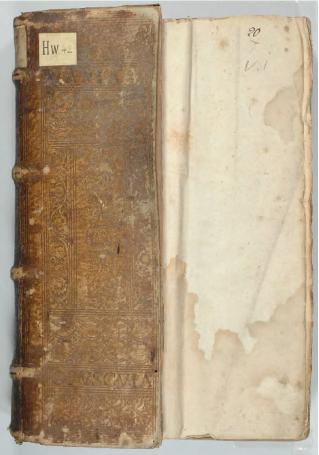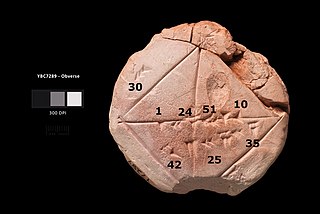
Hipparchus was a Greek astronomer, geographer, and mathematician. He is considered the founder of trigonometry, but is most famous for his incidental discovery of the precession of the equinoxes. Hipparchus was born in Nicaea, Bithynia, and probably died on the island of Rhodes, Greece. He is known to have been a working astronomer between 162 and 127 BC.

The history of mathematics deals with the origin of discoveries in mathematics and the mathematical methods and notation of the past. Before the modern age and the worldwide spread of knowledge, written examples of new mathematical developments have come to light only in a few locales. From 3000 BC the Mesopotamian states of Sumer, Akkad and Assyria, followed closely by Ancient Egypt and the Levantine state of Ebla began using arithmetic, algebra and geometry for purposes of taxation, commerce, trade and also in the patterns in nature, the field of astronomy and to record time and formulate calendars.

Claudius Ptolemy was an Alexandrian mathematician, astronomer, astrologer, geographer, and music theorist who wrote about a dozen scientific treatises, three of which were important to later Byzantine, Islamic, and Western European science. The first was his astronomical treatise now known as the Almagest, originally entitled Mathematical Treatise. The second is the Geography, which is a thorough discussion on maps and the geographic knowledge of the Greco-Roman world. The third is the astrological treatise in which he attempted to adapt horoscopic astrology to the Aristotelian natural philosophy of his day. This is sometimes known as the Apotelesmatika but more commonly known as the Tetrábiblos, from the Koine Greek meaning "Four Books", or by its Latin equivalent Quadripartite.

The zodiac is a belt-shaped region of the sky that extends approximately 8° north and south of the ecliptic, the apparent path of the Sun across the celestial sphere over the course of the year. Also within this zodiac belt appear the Moon and the brightest planets, along their orbital planes. The zodiac is divided along the ecliptic into 12 equal parts ("signs"), each occupying 30° of celestial longitude. These signs roughly correspond to the astronomical constellations with the following modern names: Aries, Taurus, Gemini, Cancer, Leo, Virgo, Libra, Scorpio, Sagittarius, Capricorn, Aquarius, and Pisces.
Sexagesimal, also known as base 60, is a numeral system with sixty as its base. It originated with the ancient Sumerians in the 3rd millennium BC, was passed down to the ancient Babylonians, and is still used—in a modified form—for measuring time, angles, and geographic coordinates.

The Almagest is a 2nd-century mathematical and astronomical treatise on the apparent motions of the stars and planetary paths, written by Claudius Ptolemy in Koine Greek. One of the most influential scientific texts in history, it canonized a geocentric model of the Universe that was accepted for more than 1,200 years from its origin in Hellenistic Alexandria, in the medieval Byzantine and Islamic worlds, and in Western Europe through the Middle Ages and early Renaissance until Copernicus. It is also a key source of information about ancient Greek astronomy.
Otto Eduard Neugebauer was an Austrian-American mathematician and historian of science who became known for his research on the history of astronomy and the other exact sciences as they were practiced in antiquity and the Middle Ages. By studying clay tablets, he discovered that the ancient Babylonians knew much more about mathematics and astronomy than had been previously realized. The National Academy of Sciences has called Neugebauer "the most original and productive scholar of the history of the exact sciences, perhaps of the history of science, of our age."

Greek mathematics refers to mathematics texts and ideas stemming from the Archaic through the Hellenistic and Roman periods, mostly from the 5th century BC to the 6th century AD, around the shores of the Mediterranean. Greek mathematicians lived in cities spread over the entire region, from Anatolia to Italy and North Africa, but were united by Greek culture and the Greek language. The development of mathematics as a theoretical discipline and the use of deductive reasoning in proofs is an important difference between Greek mathematics and those of preceding civilizations.
Science in the ancient world encompasses the earliest history of science from the protoscience of prehistory and ancient history through to late antiquity. In ancient times, culture and knowledge were passed on generation to generation by means of oral tradition. The development of writing further enabled the ability to preserve knowledge and culture, allowing communication to travel across generations with greater fidelity. The earliest scientific traditions of the ancient world developed in the Ancient Near East with Ancient Egypt and Babylonia in Mesopotamia. Later traditions of science during classical antiquity were advanced in Ancient Persia, Ancient Greece, Ancient Rome, Ancient India, Ancient China, and ancient Pre-Columbian Mesoamerica. Aside from alchemy and astrology that waned in importance during the Age of Enlightenment, civilizations of the ancient world laid the roots of various modern sciences. These include astronomy, calendrical science, mathematics, horology and timekeeping, cartography, botany and zoology, medicine and pharmacology, hydraulic and structural engineering, metallurgy, archaeology, and many other fields.

Babylonian mathematics is the mathematics developed or practiced by the people of Mesopotamia, from the days of the early Sumerians to the centuries following the fall of Babylon in 539 BC. Babylonian mathematical texts are plentiful and well edited. With respect to time they fall in two distinct groups: one from the Old Babylonian period, the other mainly Seleucid from the last three or four centuries BC. With respect to content, there is scarcely any difference between the two groups of texts. Babylonian mathematics remained constant, in character and content, for over a millennium.

Babylonian astronomy was the study or recording of celestial objects during the early history of Mesopotamia. The numeral system used, sexagesimal, was based on sixty, as opposed to ten in the modern decimal system. This system simplified the calculating and recording of unusually great and small numbers.
David Edwin Pingree was an American historian of mathematics in the ancient world. He was a University Professor and Professor of History of Mathematics and Classics at Brown University.
The stadion, also anglicized as stade, was an ancient Greek unit of length, consisting of 600 Ancient Greek feet (podes). Its exact length is unknown today; historians estimate it at between 150 m and 210 m.
Noel Mark Swerdlow was a professor emeritus of history, astronomy and astrophysics at the University of Chicago. He was a visiting professor at the California Institute of Technology.
Hermann Hunger, an Austrian Assyriologist, professor emeritus of Assyriology at the University of Vienna, from which he retired in 2007. He has been recognized for his work on Babylonian astronomy and celestial omens.

The Babylonian astronomical diaries are a collection of Babylonian cuneiform texts that contain systematic records of astronomical observations and political events as well as predictions, based on astronomical observations. They also include other information such as commodity prices for particular dates and weather reports.
Jesper Lützen is a Danish historian of mathematics and the physical sciences.
Lis Brack-Bernsen is a Danish and Swiss mathematician, historian of science, and historian of mathematics, known for her work on Babylonian astronomy. She is an extraordinary professor of the history of science at the University of Regensburg.
Christine Proust is a French historian of mathematics and Assyriologist known for her research on Babylonian mathematics. She is a senior researcher at the SPHERE joint team of CNRS and Paris Diderot University, where she and Agathe Keller are co-directors of the SAW project headed by Karine Chemla.
This is a bibliography of water clocks.









